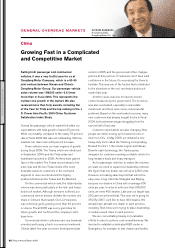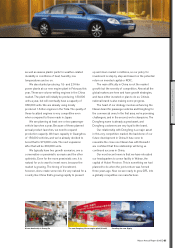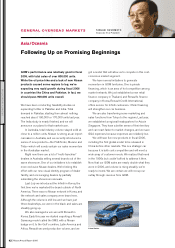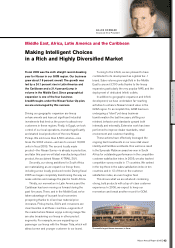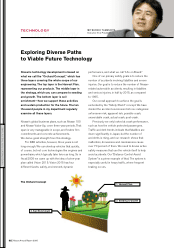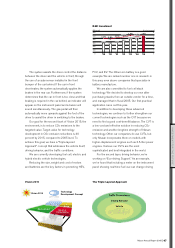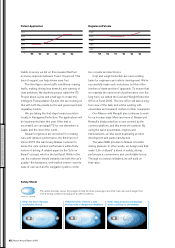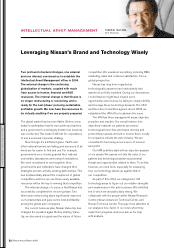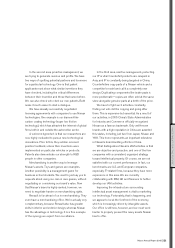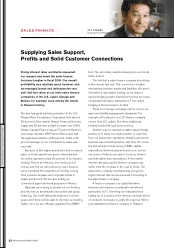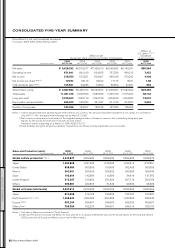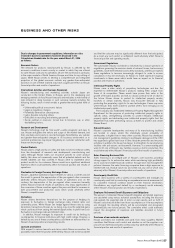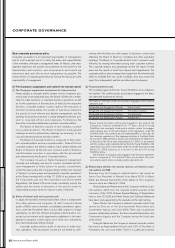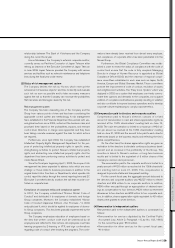Nissan 2006 Annual Report Download - page 51
Download and view the complete annual report
Please find page 51 of the 2006 Nissan annual report below. You can navigate through the pages in the report by either clicking on the pages listed below, or by using the keyword search tool below to find specific information within the annual report.
QQuuaalliittyy
QUALITY
Seeking Superior Quality
in Every Category and Region
Nissan’s quality in Japan remains at the highest
level. We’ve had some issues in other regions,
but for the past few years our overall quality has
been rising. For example, according to the J. D.
Power and Associates 2006 Initial Quality Study
(IQS), our rating improved from 16th to 12th
place. When the three-year Nissan Value-Up
period ends we intend to be among the top
three globally in every category. To accomplish
this, we are instituting worldwide the same
quality assurance methodologies that work for
us in Japan.
This is crucial, because there will be 70 production
starts during the Nissan Value-Up period, and we are
also expanding geographically. Any such expansion
carries an inherent risk for quality—new products and
regions bring new parts, processes and suppliers.
This is particularly true in leading competitive
countries, or LCCs, where suppliers generally have
less experience with Nissan.
Nissan does not have keiretsu connections. We
need strong supplier partnerships, because suppliers
provide most of our parts and represent 70 percent
of our costs. To minimize the attendant risks, we are
bringing several supplier quality assurance initiatives
online, including the Supplier Score Card, the Global
Supplier Quality Meeting, and the Nissan Quality
Award system.
A primary Nissan Value-Up goal is to reduce our
warranty costs by 25 percent from fiscal 2004. We
are on the right track in fiscal 2005. Since our
worldwide production volume is going up, I’m
forecasting that total warranty costs will be fairly
stable after 2008. On a per-vehicle basis, though,
they will continue to fall.
We will open a Field Quality Center at the Nissan
Technical Center sometime before the end of 2006.
The new facility will speed up and improve our quality
analysis of parts and enhance communication with
both our engineers and suppliers.
Until 2006, our division was responsible only for
product quality, but we now oversee sales and
service quality as well. This makes sense, because
the functions go hand in hand, and improving their
processes and methodology is a unified concern.
While the sales function will remain largely
independent, we will monitor services more closely
because of their tighter relationship to product
quality. Our name recently changed to Total
Customer Satisfaction to reflect the wider scope of
our responsibilities.
A related development is the customer
satisfaction officer or CSO position. We have one
CSO each for Japan, North/South America, Europe
and GOM managing product quality and sales and
service quality. We are also taking greater advantage
of our ten Global Quality Lead Teams, or GQLTs,
mostly NTC engineering people with some members
from other regions on the sub-teams.
Our partnership with Renault continues to pay off.
One initiative involves developing rules for Alliance
projects such as the common powertrain, the New
Cabstar, a new LCV and the 2.0-liter diesel. We have
internal rules, of course, but sharing rules with
Renault allows us to construct a more global and
versatile approach.
We are also working to standardize our quality
management in North America, Europe and GOM,
which occasionally manage processes differently.
We’ve recently become major shareholders in many
GOM operations, so we can control quality more
directly. I believe these globally oriented
methodologies and standards, such as supplier
quality assurance and GQLT activities, the Quality
Award system, and supplier meetings will boost
Nissan’s quality worldwide.
EIJI IMAI
Senior Vice President
Nissan Annual Report 2005 49
INVESTMENT FOR THE FUTURE



